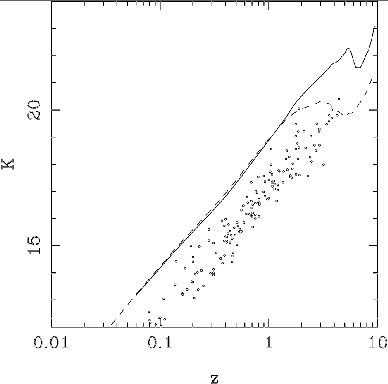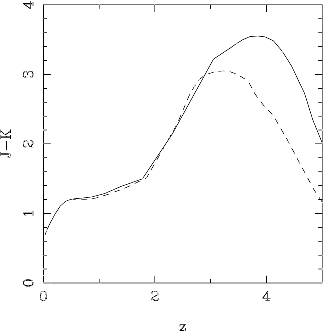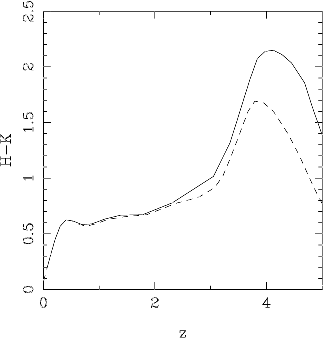Technical requirements
Survey depth. Using the models of J.S. Dunlop (private
communication) we have estimated the K-band magnitude of a passively
evolving L* elliptical galaxy as a function of redshift, assuming a
formation redshift z=10 (Figure 6.1) and a period of star formation
extending to z=3 or terminating at z=5. We find that an L* elliptical
galaxy at z=3 in a lambda-dominated cosmology would have a total
magnitude in the range K=20-22, depending on the duration of the
star-forming phase. Alternatively one can extrapolate the observed K-z
diagram for brighter (4L*) elliptical galaxies, as traced by the hosts
of luminous radio galaxies (shown as data points on Figure 6.1). To
convert to an L* elliptical (assuming, of course, that these follow a
similar evolutionary track) one would predict a total magnitude K~21.5
at z=3 (using dK=2.5 log(4)=1.5 mag).

Figure 6.1. Predicted K-z Hubble diagrams for
passively evolving L* ellipticals, produced by J.S. Dunlop (based on
the models of Jimenez et al. 1999). Both models assume a formation
redshift zf=10. The model shown by the dashed line shows
residual star formation to z=3, with a more rapid burst of star
formation for the solid line (terminating at z=5). We assume a
cosmology with omegam=0.3, lambda=0.7 and
Ho=70. For comparison, the data points illustrate the
observed K-z relation for the hosts of powerful radio galaxies
(corresponding to 4×L* ellipticals). Note that these data track
the faint model predictions with very little dispersion.
However, we need to survey to a considerably fainter point source
magnitude depth. Elliptical galaxies are large extended sources and
hence aperture correction issues must be taken into account. These
effects may have led to a systematic underestimate of the prevalence
of large elliptical galaxies at high redshift in previous deep surveys
(Dunlop & Gloag, in preparation). A large elliptical galaxy will have
a half-light radius of r1/2~10 kpc, corresponding to ~1
arcsec in a lambda-dominated cosmology (1<z<4). An aperture of
radius 3r1/2, i.e. a 6 arcsec diameter, is required to
capture >90% of the light and so provide an accurate total
magnitude. Of course the galaxies may transpire not to be this large,
but we stress that to prove this we still need to be able to make a
meaningful large aperture measurement. The key point is that to
establish both the half-light radius and total magnitude of a
high-redshift galaxy with confidence requires that meaningful
measurements can still be achieved as the aperture is expanded out to
a diameter ~6 arcsec.
For median seeing, the point-source depths used throughout this
proposal correspond approximately to using a 1 arcsec aperture, as
this optimises the S/N. If we detect K=21.5 in a 6 arcsec aperture,
then the through-aperture magnitude detected to the same S/N in a
1 arcsec aperture is K=21.5 + 2.5 log(6) = 23.4. However the
equivalent point source giving such a through-aperture magnitude is
K~22.7. Overall, we see that a survey with a depth corresponding to a
point-source limit of K=23 will be able to detect L* passively
evolved ellipticals to z=3 (5 sigma) through the necessary range of
apertures.
Filter choice. Colour information is also vital for
discriminating between objects, and for the determination of
photometric redshifts, particularly using the 4000Å break as it
moves through the I, J, & H bands over the range 1<z<4 (see
Figures 6.2, 6.3). Photometric redshifts need two points longward of
the 4000Å break and so should work up to roughly z=3. To effectively
separate passive ellipticals from starbursts, we need to be able to
detect colours of J-K ~2 and H-K ~1, otherwise the majority of our
sample objects may be K-band detections only. By the same reasoning,
it is also highly desirable to obtain very deep I-band data to
complement the UDS. For an ERO detection, depths of I~27-28 will be
required to match the above. SuprimeCam on Subaru would be ideal for
such imaging.

Figure 6.2. J-K colours as a function of redshift for the
2 evolution models illustrated in Fig. 6.1.

Figure 6.3. J-H colours as a function of redshift for the
2 evolution models illustrated in Fig. 6.1.
Survey area. Our prime goal is to measure the
abundance of high redshift passive ellipticals. A survey of
approximately one square degree size is needed for confident
statistics. The simplest strategy would be to stack repeated exposures
at an identical pointing, resulting in four separated surveys totaling
0.21 sq. degs. However as well as compromising the statistics, this
would damage our secondary aim at measuring the clustering amplitude
of various populations, which really needs a contiguous area probing
~100Mpc. A contiguous field is also highly desirable for obtaining
complementary multiwavelength data in an efficient manner. It may
well be best to make such a deep stacked survey on a finely gridded
pattern, but the optimum pattern needs further research. For the
purposes of modelling, we assume for now that the UDS is a
straightforward tile made with four macro-steps, making a filled-in
area of area 0.77 sq deg, and mosaic efficiency Em=0.93".


